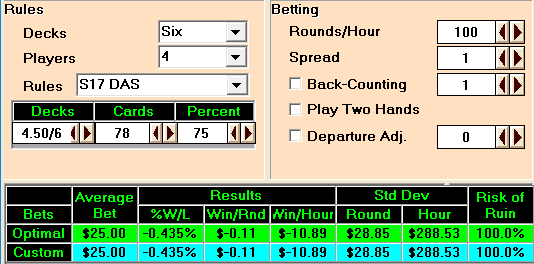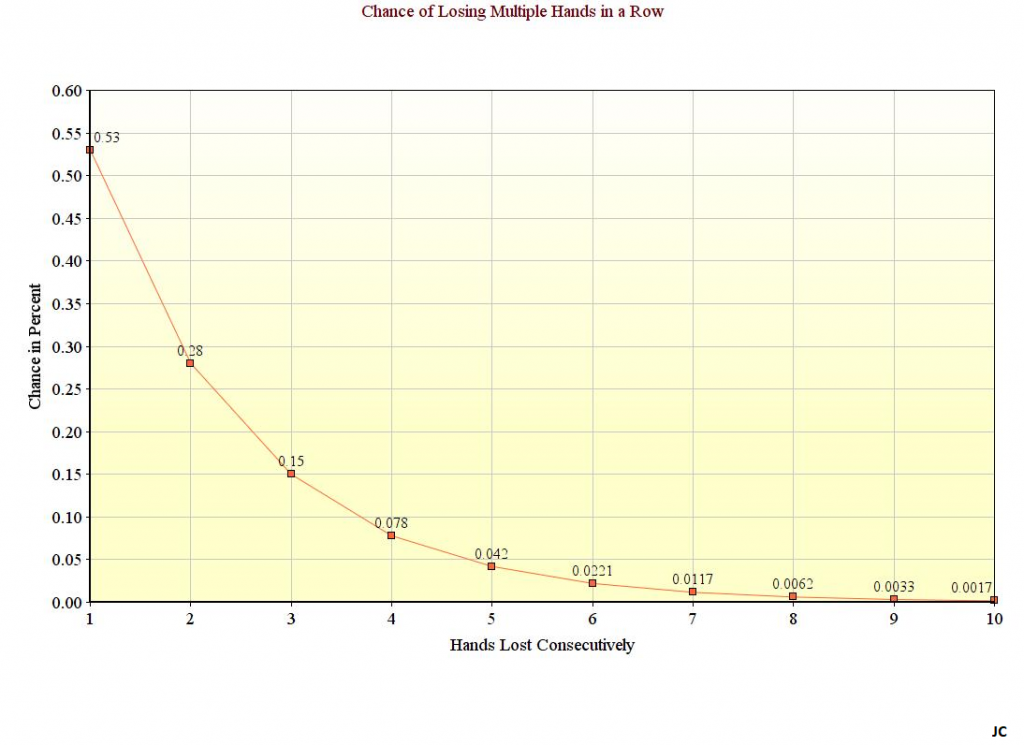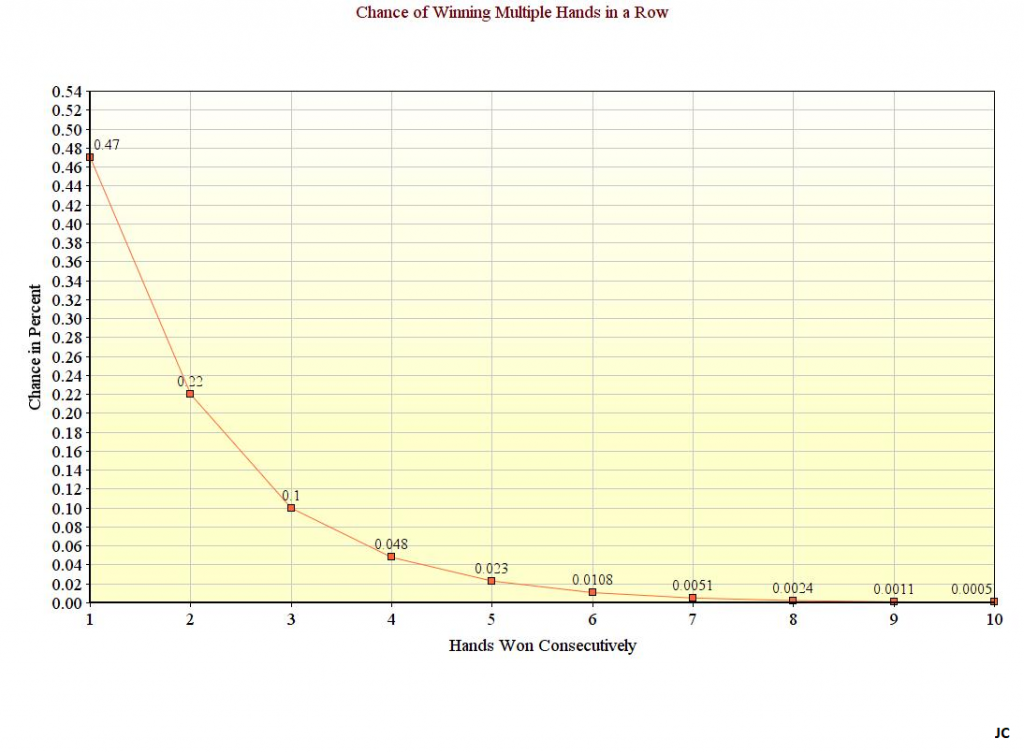Blackjack Betting Strategies Debunked
Analyzing the Systems and Debunking the Myths
Let’s start this discussion with a precursor and caveat—the only way you will ever win money long-term (that is, over thousands of hours of play) is to count cards and raise or lower your bet based on an accurate counting system. Of course, this takes hundreds of hours of practice and study, and you’ll soon wear out your welcome wherever you play. So if you’re just spending a week in Vegas and you want to learn how to come away with a winning trip, or you are just an occasional player who wants to limit their losses, we can help.
How can a betting strategy help you win? In the short term, betting systems can help you reduce variance, win large amounts in one session, avoid huge short-term losses, and have fun experimenting with different bet spreads based on your specific goals. So what are the different blackjack betting strategies, and how do they work? Let’s take a look at the good, the bad, and the ugly.
The Flat Bet
Flat betting is a method employed by a large majority of gamblers. They understand their limits and want to do their best to keep their bankroll intact throughout the night. When you flat bet, you generally bet the table minimum and never increase or decrease your bet for any reason.
The Positives: By employing a consistent betting pattern, you’ll avoid many of the large swings of standard deviation that are common in blackjack. If you’re looking for longevity without risk, and you don’t need the thrill of a big bet to have fun, flat betting is likely your best course of action.
If you are playing a six-deck game with S17 DAS rules, and you are betting $25.00 per hand at roughly 100 hands per hour, you are expected to lose $10.89 an hour playing perfect basic strategy. $10 an hour sounds like cheap entertainment to me, especially if you’re getting free drinks and casino comps to reduce that number to near 0, if not positive, by slowing down play. Most importantly, you’ll never have to return home to your wife explaining how you went all in and lost all of your vacation money in one night.

The Negatives: You’ll never lose it all in one night, but you definitely won’t win it all either. Your losses will be slow and steady, and your wins will be small. The standard deviation of the game above amounts to about $288 an hour, so you’ll never be a huge winner or loser. More so, your risk of losing in the long run is 100% (just like any betting progression). Given enough time, you will lose even a million-dollar bankroll—but at $25/hand, that bankroll will likely outlive you.
The Negative Betting Progressions
A Progression is a system in which players increase their bets after a specific event. In the case of a negative progression, that event is a loss, playing to get back to even. Because your win comes at a higher bet, the theory is that you’ll win bigger than you lose, coming out even or a winner. Let’s take a look at how this system works in reality.
The Martingale System
One of the most popular betting systems is the Martingale System. This negative betting system is a simple strategy in which you double your bet upon a loss. The idea behind the Martingale is that you will never be behind for long, because odds are you will win at least 1 hand to keep you even while enjoying an evening of free drinks and never-ending gambling. We don’t really need to analyze the game with this progression, because the results are the same no matter what you’re playing—you go bust. Given enough time, and often in short order, you lose your bankroll.
Here’s how it works:
- $25 bet — lose and double up
- $50 bet — lose and double up
- $100 bet —lose and double up
- $200 bet — win and you’re back in business, up $25.
- Back to a $25 bet
The Positives: If you avoid a string of bad luck (negative variance) you should be able to play for a while without losing a cent. If your bankroll is large, you can survive a string of losses to make up for it with a win at the tail end.
The Negatives: If you have bad luck, you’ll quickly run out of money, or run up against the table max before long. Let’s take a look at the 4th bet and reimagine a different outcome.
- $200 bet — split 2x, double 2x, bet totaling $1000, all which end in a loss. All the sudden, your next, 5th bet needs to be $2000. You’re now up against the table max, and if you lose again, you can’t double your next bet. Plus, you probably don’t have the bankroll for another split or double anyway, if you even have the bankroll for the 5th $2000 bet. You had $3000, and you thought you could never lose—but you didn’t even last 30 minutes.
Wins and losses for blackjack aren’t 50-50, even if we disregard pushes. For a perfect basic strategy player, the win-loss ratio is closer to 47 wins, 53 losses—and you’ll be perpetually chasing your losses. As a result, the Martingale system is flawed. Our advice is to avoid the Martingale like the plague.
The below chart expresses our chance of losing X number of hands in a row. Ignoring pushes, we win 47% of the time and lose 53% of the time playing basic strategy.

The Positive Betting Progressions
With a positive betting progression, you raise your bets with each win, funding larger bets with the sum of your smaller wins. This betting style feels more natural for many players, and many play it without even realizing that it’s a system. Often players will continually raise their bets after a win to take advantage of a perceived hot-streak or weak dealer. This system is more conservative than its negative betting counterpart, as a string of losses will not pile up and knock out your bankroll as fast or as often. If you are on a huge winning streak, you stand to make a big win, but eventually a loss will set you back to the beginning. As a result, many players use modified progression systems like the 1-3-2-6 betting pattern.
1-3-2-6 System
This progressive betting strategy works just as the name implies, betting in units. The key is to remember that your bet is not raised unless you win. So, for instance, if you lose 4 hands in a row, your bet never raises above 1 unit. Once you finish the progression—which is to say you win with 1, 3, 2, and 6 units, you start back from the beginning at 1 unit.
The Positives: This system allows for less of an “all-in” strategy than a normal progression which dictates continually raising your bets during a winning streak until you decide to quit or you hit a loss. By winning your first and second bets on 1 and 3 units, you’ll have won 4 units. If you lose your 3rd bet, you’ll still be ahead by 2 units. Because it’s less likely to win 3 in a row than 2, you may win more consistently in the short-term.
The Negatives: You won’t achieve as big of a win as you potentially can with a traditional positive progression betting system. For example, if you start out with a $25 bet and win 4 in a row ($25, $75, $50, $150) you would win a total of $300. A straightforward progressive system with a $25 bet and 4 wins in a row ($25, $50, $100, $200) would win a total of $375.
The below chart expresses our chance of winning X number of hands in a row. Ignoring pushes, we win 47% of the time and lose 53% of the time playing basic strategy.

Oscar’s Blackjack Betting System
The most touted system for short-term blackjack winnings is Oscar’s Betting System, often called Oscar’s Grind. It combines some of the best features of both positive and negative betting progressions. Oscar’s grind aims to make 1 unit of profit with each run. Once a unit is won, the entire progression begins anew. Remember, you never raise your bet after a loss, only wins. It is a slow-and-steady system designed to grind out wins and avoid huge losses.
Here is an example run:
1st Bet: 1 Unit, Result: L, Total: -1
2nd Bet: 1 Unit, Result: L, Total: -2
3rd Bet: 1 Units, Result: W, Total: -1
4th Bet: 2 Units, Result: W, Total: +1 (Stopping Point)
And Another:
1st Bet: 1 Unit, Result: L, Total: -1
2nd Bet: 1 Unit, Result: L, Total: -2
3rd Bet: 1 Units, Result: L, Total: -3
4th Bet: 1 Units, Result: W, Total: -2
5th Bet: 2 Units, Result: L, Total: -4
6th Bet: 2 Units, Result: W, Total: -2
7th Bet: 3 Units, Result: W, Total: +1 (Stopping Point)
The Positives: You can continue to bet and run into a string of losses without completely losing your bankroll, unlike most negative progressions. If you believe in winning streaks and positive table energy, this progression is for you. You’re never struggling to pull yourself out of a big loss with big bets.
The Negatives: Patience is definitely a virtue with this system. The mindset is slow and steady wins. If you’re looking to accrue comps and play a low-variance game, this system is for you. If you want big wins, you’re barking up the wrong blackjack tree. It is also a slow, calculating system, so you may have difficulty employing it at the tables without a little practice.
Conclusive thoughts by LV Bear
There is no good reason to not learn a system of advantage play. Yes, some folks play blackjack for the “entertainment value,” but they should be aware of how much their expected losses will be, progression systems or otherwise. Those losses pile up over months and years of ploppy play. It is not difficult to learn rudimentary card-counting skills that will give the player at least a small advantage, even if not used to their full potential.


